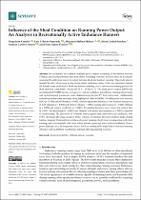Por favor, use este identificador para citar o enlazar este ítem:
https://repositorio.usj.es/handle/123456789/902
| Título : | Influence of the Shod Condition on Running Power Output: An Analysis in Recreationally Active Endurance Runners |
| Autor: | Jaen-Carrillo, Diego

Roche-Seruendo, Luis Enrique 


Molina-Molina, Alejandro 


Cardiel-Sanchez, Silvia 

Carton-Llorente, Antonio 

García-Pinillos, Felipe 


|
| Palabras clave : | Barefoot; Footstrike; Siffness; Sensor; Wearable |
| Fecha de publicación: | 26-jun-2022 |
| Editorial : | MDPI |
| Citación : | Jaén-Carrillo, D.; Roche-Seruendo, L.E.; Molina-Molina, A.; Cardiel-Sánchez, S.; Cartón-Llorente, A.; García-Pinillos, F. Influence of the Shod Condition on Running Power Output: An Analysis in Recreationally Active Endurance Runners. Sensors 2022, 22, 4828. https://doi.org/10.3390/s22134828 |
| Resumen : | Several studies have already analysed power output in running or the relation between VO2max and power production as factors related to running economy; however, there are no studies assessing the difference in power output between shod and barefoot running. This study aims to identify the effect of footwear on the power output endurance runner. Forty-one endurance runners (16 female) were evaluated at shod and barefoot running over a one-session running protocol at their preferred comfortable velocity (11.71 _ 1.07 km_h-1). The mean power output (MPO) and normalized MPO (MPOnorm), form power, vertical oscillation, leg stiffness, running effectiveness and spatiotemporal parameters were obtained using the Stryd™ foot pod system. Additionally, footstrike patterns were measured using high-speed video at 240 Hz. No differences were noted in MPO (p = 0.582) and MPOnorm (p = 0.568), whereas significant differences were found in form power, in both absolute (p = 0.001) and relative values (p < 0.001), running effectiveness (p = 0.006), stiffness (p = 0.002) and vertical oscillation (p < 0.001). By running barefoot, lower values for contact time (p < 0.001) and step length (p = 0.003) were obtained with greater step frequency (p < 0.001), compared to shod running. The prevalence of footstrike pattern significantly differs between conditions, with 19.5% of runners showing a rearfoot strike, whereas no runners showed a rearfoot strike during barefoot running. Running barefoot showed greater running effectiveness in comparison with shod running, and was consistent with lower values in form power and lower vertical oscillation. From a practical perspective, the long-term effect of barefoot running drills might lead to increased running efficiency and leg stiffness in endurance runners, affecting running economy. |
| URI : | https://repositorio.usj.es/handle/123456789/902 |
| ISSN : | 1424-8220 |
| Aparece en las colecciones: | Artículos de revistas |
Ficheros en este ítem:
| Fichero | Descripción | Tamaño | Formato | |
|---|---|---|---|---|
| Influence of the Shod Condition on Running Power Output.pdf | 473,23 kB | Adobe PDF |  Visualizar/Abrir |
Este ítem está sujeto a una licencia Creative Commons Licencia Creative Commons

